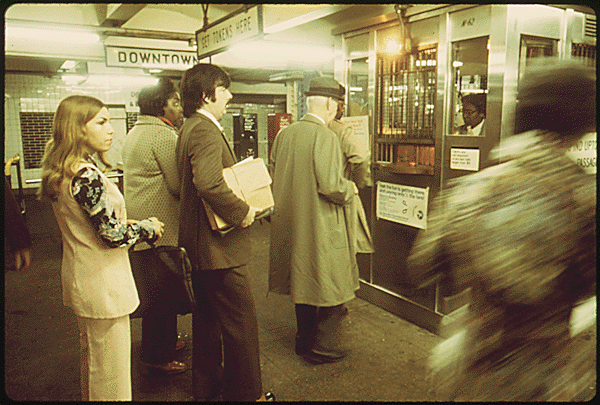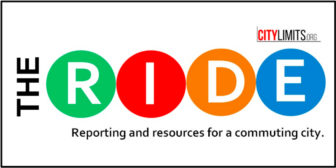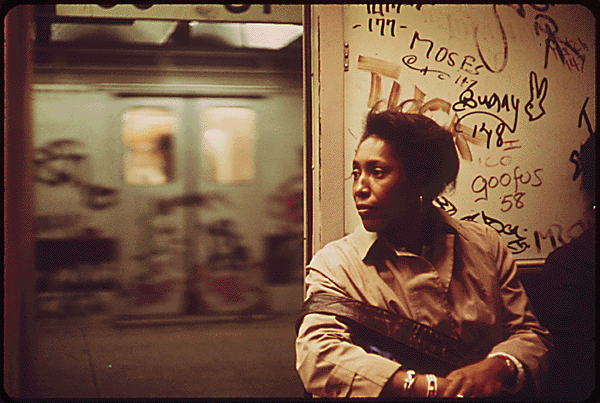
National Archives/Jim Pickerell
Subway riders wait in line to buy tokens in 1974.
This story was produced through the City Limits Accountability Reporting Initiative For Youth (CLARIFY), City Limits’ paid training program for aspiring public-interest journalists.
At a public hearing in December, dozens of people filled the auditorium at York College in Jamaica, Queens, to sound off on the MTA’s plan to raise fares and tolls in 2019. Tensions were high as speakers accused the Transportation Authority’s board of corruption, called them cowards and railed against unreliable service. Some sported yellow safety vests and waved protest signs with phrases like “No fare hike for a subway that isn’t accessible!” and “Our subways need elevators. Not racist ‘Broken Windows’ policing!” plastered on white and yellow poster board.
“I think at $3, it’s a ridiculous amount to ask lower-income commuters,” said Rhonda Hamilton, among those who testified for the two minutes each speaker was given to address MTA officials. “Do think humanly about the effect that this is having on a population that is not wealthy.”
The cash-strapped MTA has unveiled two proposals for MetroCard fares, which are expected to take effect in March 2019. The first would keep the current $2.75 fare price, but eliminate the existing 5 percent bonus for purchases over $5.50. The second proposal would increase the base fare to $3, with an increased 10 percent bonus on any transaction over $6.00, making the fare $2.73 once adjusted for the bonus. The MTA’s board approved a $17 billion budget earlier this month that includes the projected price hikes, though a formal vote is expected to take place in January.
The fare increase will be the sixth faced by riders since 2009, and the city’s transit costs have been hiked more than a dozen times since the subway first opened more than a century ago. City Limits took a dive into news archives to see how city dwellers reacted to the prospect of pricier commutes over the years, and found that while things have changed, much has stayed the same—including the fact that New Yorkers aren’t shy when it comes to voicing opinions.
Below are some of the more colorful reactions to subway and bus fare hikes through the years, pulled from news reports at the time.
1904: The subway opened with great fanfare and rides that cost only a nickel, drawing crowds so large that “the ticket sellers could not get their breath,” a New York Times story from the first day of service recounts. “The fact that every man had his nickel ready, and lone women their inevitable five pennies well in hand, greatly expedited the sale of tickets,” the story notes. The paper that day also records what was perhaps the first subway robbery: Henry Barrett, of West 46th Street, reported the theft of a $300 diamond horseshoe pin during his opening day ride.
The New York Public Library Digital Collections
A newsstand and subway station entrance on 8th Avenue in 1937.
1948: The nickel fare stayed in place for more than four decades, but was hiked to 10 cents a ride this year to cover raises for city employees and school and hospital improvements, according to news reports at the time. The price change went into effect at midnight July 1, and New Yorkers made a party of it, racing to subway stations in the hopes of being the first rider to drop a dime into the turnstile. Few protested or refused to pay; most just accepted the new price without incident, a Times article notes: “Rebels turned up here and there, in the Times Square station, but they were tipsy in most cases,” it describes. “One middle-aged woman exploded in wrath against Charles Beever, the station supervisor, but she finally dropped her dime, too, and went below decks, fuming and ranting.”
1953: The fare went up to 15 cents, prompting one member of newly-formed NYC Transit Authority to resign in protest. Subway tokens were also introduced this year. In a letter to the editor printed in the Times a week before the fare hike went into effect, one Long Island rider lamented poor conditions on the subway: “During the summer, months of accumulated dirt and dust are being circulated by the whirring electric fans. Only recently one of the fans dislodged some of the dirt and flung it right into the face of the rider seated next to me and onto my freshly laundered dress,” she wrote. “With the 15-cent fare imminent, it is hoped the additional funds will be diverted in part to giving us clean trains to ride in.”
1966: Months after the city was crippled for more than a week by a transit strike, the Transit Authority was in financial crisis, prompting another rise in subway fares to 20 cents. “I’m just an average man, and I don’t make much money,” one elderly commuter told the Times the day the increase went into effect. “But who am I to fight City Hall?”
National Archives/Jim Pickerell
35-cent subway tokens, the cost of the fare starting in 1972.
1970s: State and city lawmakers negotiated for months to retain the 20-cent fare, with then-Mayor John Lindsay asking the state to pony up the cash to do so while the MTA chairman insisted it was the city’s job to subsidize transit’s operating deficit (sound familiar?). Some advocacy groups at the time pushed for the city to impose tolls on the East River bridges to cover the budget gap, while Walter Hoving, chairman of jewelry store Tiffany’s, suggested a tax on private cars (sound even more familiar?)
When the fare was hiked to 30 cents in January, 12 commuters were arrested and dozens of others issued summonses for entering the subways without paying, according to the Times. In Far Rockaway, where riders lived in a double-fare zone and had to pay 60 cents to enter Manhattan, hundreds protested and a firecracker was set off inside a phone booth. “You wouldn’t mind paying more if the trip was faster and the trains were warmer,” one rider told the paper.
Fares were hiked again a year later, in 1972, to 35 cents. In 1975, they increased to 50 cents, prompting more protests, including several people who used chains to prop open the subway gates at the 23rd Street station so riders could enter without paying. New Yorkers were “mumbling or screaming or looking homicidal,” one woman described to the “But if you suggest doing something about it together, they look at you like you’re some kind of nut.”
1980s: In June of 1980, the fare went up a dime—from 50 to 60 cents—to help close the MTA’s budget deficit, despite then-Governor Hugh Carey’s earlier campaign pledge not to raise fares until 1982. Public hearings brought out angry attendees, including a man who “called on the M.T.A. board and Governor Carey to resign,” and a woman who said “that her husband would leave her if she was not quickly given a chance to speak,” a Times story recounts.
A year later, the MTA raised fares again, this time to 75 cents. “I think it’s a nice luxury item for Carey and Koch,” one man told the Times of the 15-cent rise. “They’ll be able to eat red snapper more often during the week.” The price hike came at a time of deteriorating transit service, further enraging riders, who had been driven to a state of “outrage, bordering at times on hysteria,” the newspaper concluded. “I really believe, for the first time, that there has to be a violent overthrow of government,” quipped another commuter.
National Archives/Erik Calonius
A woman rides a graffiti-covered subway train in 1973.
Fares rose again in 1984, then jumped to $1 at the start of the 1986, when the subway-patrolling Guardian Angels organized a “fare strike,” stuffing debris into the token slots of subway turnstiles. Members of the group were arrested in another protest weeks before, for tossing dimes at MTA officials. “All we are doing is bringing to the forefront the rage of straphangers who are flying over their turnstiles in record numbers,” the group’s leader Curtis Sliwa told United Press International.
1990s: The fare went up to $1.15 in 1990, and a public hearing on the change lasted a whopping 11 hours, according to the Times, which described the 150 attendees who testified as “outraged.”
Another hike came in 1991, and a third in 1995, when the MTA voted to hike fares to $1.50. The plan was met by protests at spirited hearings where attendees “carried caricatures of Mayor Giuliani and Gov. Pataki ‘The Monsters Who Ate Mass Transit,'” a Daily News article at the time describes. “You fat cats in your $500 suits!” an elderly protester shouted at the MTA board, according to the paper. Another speaker read a poem she wrote for the occasion: “There stands before me a board named the MTA / They don’t seem to be listening to anything we say.”
2000s: In 2003, the subway token was officially retired from use, and the fare went up to $2 from $1.50. “I’m ready to move out of New York,” Queens resident Frank Carroll told Newsday the day the price change went into effect.
Fares increased again in 2008 and in 2009, when in the midst of the recession, the MTA proposed a number of “doomsday” service cuts in addition to fare hikes. The plan elicited a strong public reaction: At one hearing, a man was arrested for taking off his shoe and threatening to throw it at then-MTA head Elliot Sander. “This shoe’s for you,” the Post quotes the footwear protester as saying. In the end, lawmakers passed a $2.26 billion bailout for the MTA that allowed it to avoid the more severe cuts, and which raised fares from $2 to $2.25 per ride and $81 to $89 for a monthly, according to the Associated Press.
Adi Talwar
Subway tokens were retired in 2003, and replaced by the MetroCard.
2010-Present: In 2010, the base fare stayed at $2.25, but the cost of single-ride tickets jumped to $2.50 and 30-day cards from $89 to $104. “Never have I seen the anger higher at this board of rich people who don’t even ride their own transit system,” an MTA station agent testified before the MTA board the day it approved the plan, according to DNAinfo. Hikes also took place in 2013, 2015 and 2017.
Though she’s unhappy at the prospect of a more expensive commute, Rhonda Hamilton, who spoke at this year’s fare hike hearing at York College earlier this month, said she was glad to have an opportunity to voice her concerns and remind the MTA that they work for the people.
“Their job is to deal with us; commuters and taxpayers,” she told City Limits. “They need to be reminded of that.”














One thought on “‘You Fat Cats in Your $500 Suits!’: A History of New Yorkers Reacting to Subway Fare Hikes”
Pingback: ‘You Fat Cats in Your $500 Suits!’: A History of New Yorkers Reacting to Subway Fare Hikes